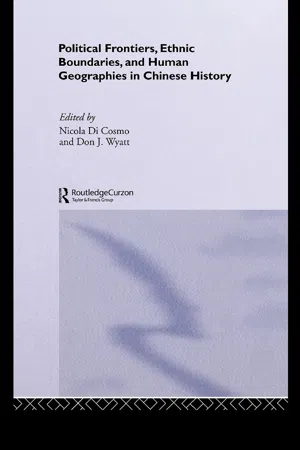
Political Frontiers, Ethnic Boundaries and Human Geographies in Chinese History
- 432 pages
- English
- ePUB (mobile friendly)
- Available on iOS & Android
Political Frontiers, Ethnic Boundaries and Human Geographies in Chinese History
About This Book
Boundaries - demanding physical space, enclosing political entities, and distinguishing social or ethnic groups - constitute an essential aspect of historical investigation.
It is especially with regard to disciplinary pluralism and historical breadth that this book most clearly departs and distinguishes itself from other works on Chinese boundaries and ethnicity. In addition to history, the disciplines represented in this book include anthropology (particularly ethnography), religion, art history, and literary studies. Each of the authors focuses on a distinct period, beginning with the Zhou dynasty (c. 1100 BCE) and ending with the early centuries after the Manchu conquest (c. CE 1800) - resulting in a chronological sweep of nearly three millennia.
Frequently asked questions
Information
1
TOWARD A SOCIAL GEOGRAPHY OF THE ZHOUYUAN DURING THE WESTERN ZHOU DYNASTY
The Jing and Zhong lineages of Fufeng county
Edward L. Shaughnessy
Fufeng county of Shaanxi province includes perhaps the most thoroughly explored extensive archaeological site in all of China. The western edge of the county, where it borders on Qishan county, comprises part of what is usually referred to as the Zhouyuan or the Plain of Zhou, the traditional homeland of the Zhou people.1 The Zhouyuan is located about one hundred kilometers to the west of Xi’an, twenty-five kilometers to the south of the Qi Shan mountain range and about the same distance to the north of the Wei River in west central Shaanxi province. As defined by modern archaeological excavations, the site covers only about ten square kilometers, slightly more than three kilometers north–south, and slightly less than that east–west, more or less bounded by the present towns of Jingdang (in Qishan county), and Huangdui and Qicun (both in Fufeng county); see Figure 1.1. Throughout later Chinese history, this small area has been the locus of numerous discoveries of early Zhou cultural artifacts, especially inscribed bronze vessels. In the 1970s, archaeologists from the Institute of Archaeology, Chinese Academy of Sciences (now Chinese Academy of Social Sciences), from the Shaanxi Provincial Institute of Archaeology, and from the cultural units of the respective counties joined forces to explore the area thoroughly. While no formal report of this archaeological campaign has yet been forthcoming, most of its significant discoveries have been published piecemeal, and there is a comprehensive cultural record of Fufeng county.2

Figure 1.1 The Zhouyuan.
Discerning families and lineages from vessels made by and for women3
In mapping these families, it will be helpful first to discuss in brief what we know of families during the Western Zhou dynasty. There was a relatively limited number of xing or surnames, the most important of these being the royal Zhou Ji. While I will refer to these xing as “families,” it might be helpful to think of them in terms of nationalities or, perhaps better, as analogous to American Indian tribes: while presumably originally deriving from a single geographical area, over time they tended to become dispersed. Some of this dispersal was due to political circumstances (for example, the Zhou policies of colonizing conquered areas with members of the royal family, or, alternatively, of compelling some families of the conquered areas to move to the Zhou homeland); some of it was due to growth and/or segmentation of families, and also to the circumstances of marriage. Family surname passed from father to children, but later texts, and also virtually all contemporary evidence, suggest that there was a strongly felt proscription against marrying within the same family. Th...
Table of contents
- Cover Page
- Title Page
- Copyright Page
- Illustrations
- Contributors
- Acknowledgments
- Table of Dynasties
- Introduction
- 1. Toward a Social Geography of the Zhouyuan During the Western Zhou Dynasty: The Jing and Zhong Lineages of Fufeng County
- 2. Mapping a “Spiritual” Landscape: Representation of Terrestrial Space In the Shanhaijing
- 3. Ethnicity and Identity: Northern Nomads As Buddhist Art Patrons During the Period of Northern and Southern Dynasties
- 4. Deep Eyes and High Noses: Physiognomy and the Depiction of Barbarians In Tang China
- 5. Raiding and Frontier Society In the Five Dynasties
- 6. “Felt Yurts Neatly Arrayed, Large Tents Huddle Close”: Visualizing the Frontier In the Northern Song Dynasty (960–1127)
- 7. The Invention of the Northern Song
- 8. The Mu’ege Kingdom: A Brief History of a Frontier Empire In Southwest China
- 9. Traveler’s Vocation: Xu Xiake and His Excursion to the Southwestern Frontier
- 10. Changing Spaces of Empire In Eighteenth-Century Qing China
- 11. Kirghiz Nomads On the Qing Frontier: Tribute, Trade, or Gift Exchange?
- 12. Envisioning New Borders for the Old China In Late Qing Fiction and Local Drama